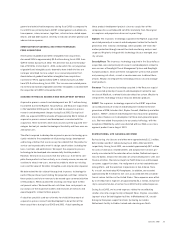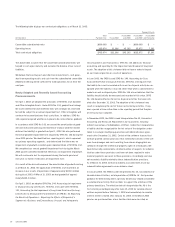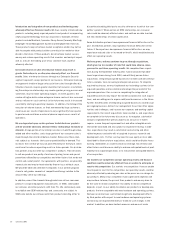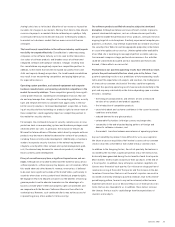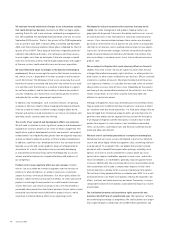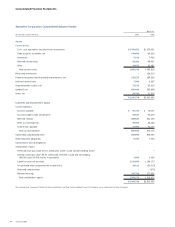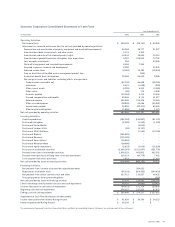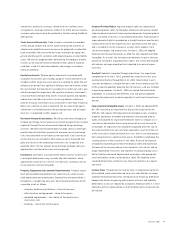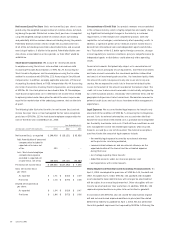Symantec 2003 Annual Report Download - page 43
Download and view the complete annual report
Please find page 43 of the 2003 Symantec annual report below. You can navigate through the pages in the report by either clicking on the pages listed below, or by using the keyword search tool below to find specific information within the annual report.
Symantec 2003 41
copyright, patent, trademark and trade secret laws. Third parties may
copy aspects of our products or otherwise obtain and use our propri-
etary information without authorization or develop similar technology
independently. All of our products are protected by copyright laws, and
we have a number of patents and patent applications pending. We may
not achieve the desired protection from, and third parties may design
around, our patents. In addition, existing copyright laws afford limited
practical protection. Furthermore, the laws of some foreign countries
do not offer the same level of protection of our proprietary rights as the
laws of the United States, and we may be subject to unauthorized use of
our products. Any legal action that we may bring to protect proprietary
information could be expensive and may distract management from day-
to-day operations.
Our inabilities to timely distribute our products and services over the
Internet, and security patches and updated virus definitions via our
LiveUpdate feature in particular, could adversely affect our business.
Our ability to maintain and increase the speed with which we provide
services to consumers and to increase the scope of these services is
limited by and dependent upon the speed and reliability of the Internet.
As we incorporate the LiveUpdate technology into more of our products,
we are increasingly reliant on the Internet as a means to distribute our
security patches and updated virus definitions to our customers. Accord-
ingly, if we, or our customers, are unable to utilize the Internet due to a
failure of technology, infrastructure or other reasons, our ability to pro-
vide services may suffer, which could lead to a decrease in revenues.
Our products are complex and are operated in a wide variety of com-
puter configurations, which could result in errors or product failures.
Because we offer very complex products, undetected errors, failures or
bugs may occur when they are first introduced or when new versions are
released. Our products often are installed and used in large-scale com-
puting environments with different operating systems, system manage-
ment software and equipment and networking configurations, which
may cause errors or failures in our products or may expose undetected
errors, failures or bugs in our products. In the past, we have discovered
software errors, failures and bugs in certain of our product offerings
after their introduction and have experienced delays or lost revenues
during the period required to correct these errors. Our customers’ com-
puter environments are often characterized by a wide variety of stan-
dard and non-standard configurations that make pre-release testing for
programming or compatibility errors very difficult and time-consuming.
Despite testing by us and by others, errors, failures or bugs may not be
found in new products or releases prior to commencement of commer-
cial shipments. Errors, failures or bugs in products released by us could
result in negative publicity, product returns, loss of or delay in market
acceptance of our products or claims by customers or others. In addi-
tion, if an actual or perceived breach of network security occurs in one
of our end customer’s security systems, regardless of whether the
breach is attributable to our products, the market perception of the
effectiveness of our products could be harmed. Because the techniques
used by computer hackers to access or sabotage networks change fre-
quently and generally are not recognized until launched against a target,
we may be unable to anticipate these techniques. Alleviating any of
these problems could require significant expenditures of our capital and
resources and could cause interruptions, delays or cessation of our
product licensing, which could cause us to lose existing or potential
customers and would adversely affect results of operations.
Most of our license agreements with customers contain provisions
designed to limit our exposure to potential product liability claims. It
is possible, however, that these provisions may not prove effective in
limiting our liability.
Increased utilization and costs of our technical support services may
adversely affect our financial results. Like many companies in the soft-
ware industry, technical support costs comprise a significant portion
of our operating costs and expenses. Over the short term, we may be
unable to respond to fluctuations in customer demand for support serv-
ices, including periods of high customer usage in which delays may be
experienced. We also may be unable to modify the format of our support
services to compete with changes in support services provided by com-
petitors. Further, customer demand for these services could cause
increases in the costs of providing such services and adversely affect
our operating results.
Over the past year, we have outsourced our North American and
European consumer support functions. As such, we are highly depend-
ent on the ongoing business success of the companies with whom we
have contracted to provide these services. If these companies experi-
ence financial difficulties, do not maintain sufficiently skilled workers
and resources to satisfy our contracts or otherwise fail to perform at a
sufficient level under these contracts, the level of support services to
our customers may be significantly disrupted, which could materially
harm our relationships with these customers.




